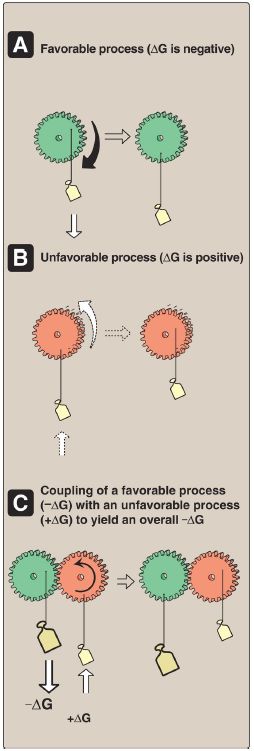
ATP: an Energy Carrier
 المؤلف:
Denise R. Ferrier
المؤلف:
Denise R. Ferrier
 المصدر:
Lippincott Illustrated Reviews: Biochemistry
المصدر:
Lippincott Illustrated Reviews: Biochemistry
 الجزء والصفحة:
الجزء والصفحة:
 10-9-2021
10-9-2021
 1699
1699
ATP: an Energy Carrier
Reactions or processes that have a large positive ΔG, such as moving ions against a concentration gradient across a cell membrane, are made possible by coupling the endergonic movement of ions with a second, spontaneous process with a large negative ΔG such as the exergonic hydrolysis of ATP . [Note: In the absence of enzymes, ATP is a stable molecule because its hydrolysis has a high Ea.] Figure 1 shows a mechanical model of energy coupling. The simplest example of energy coupling in biologic reactions occurs when the energy-requiring and the energy-yielding reactions share a common intermediate.

Figure 1 Mechanical model of the coupling of favorable and unfavorable processes. A. Gear with weight attached spontaneously turns in the direction that achieves the lowest energy state. B. The reverse movement is energetically unfavorable (not spontaneous). C. The energetically favorable movement can drive the unfavorable one. ΔG = change in free energy.
A. Common intermediates
Two chemical reactions have a common intermediate when they occur sequentially in that the product of the first reaction is a substrate for the second. For example, given the reactions

D is the common intermediate and can serve as a carrier of chemical energy between the two reactions. [Note: The intermediate may be linked to an enzyme.] Many coupled reactions use ATP to generate a common intermediate. These reactions may involve the transfer of a phosphate group from ATP to another molecule. Other reactions involve the transfer of phosphate from an energy-rich intermediate to adenosine diphosphate (ADP), forming ATP.
B. Energy carried by ATP
ATP consists of a molecule of adenosine (adenine + ribose) to which three phosphate groups are attached (Fig. 6.5). Removal of one phosphate produces ADP, and removal of two phosphates produces adenosine monophosphate (AMP). For ATP, the ΔG0 of hydrolysis is approximately –7.3 kcal/mol for each of the two terminal phosphate groups. Because of this large negative ΔG0 of hydrolysis, ATP is called a high-energy phosphate compound. [Note: Adenine nucleotides are interconverted (2 ADP ⇔ ATP + AMP) by adenylate kinase.]

Figure 1: Adenosine triphosphate (ATP).
 الاكثر قراءة في الكيمياء الحيوية
الاكثر قراءة في الكيمياء الحيوية
 اخر الاخبار
اخر الاخبار
اخبار العتبة العباسية المقدسة


